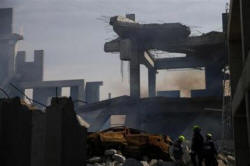|
 At
Cold War Missile Factory, Elite Rescuers Drill For Disaster At
Cold War Missile Factory, Elite Rescuers Drill For Disaster
 Send a link to a friend
Send a link to a friend
[March 26, 2014]
By John Shiffman
PERRY, Georgia (Reuters) — On a cloudless,
windswept Georgia morning 100 miles south of Atlanta, a rescuer dangled
30 feet in the air, secured by rappelling ropes, wielding a jackhammer,
as he drove the drill into a massive concrete slab designed to mimic the
1995 bombing of the federal building in Oklahoma City. It took about an
hour to punch a hole big enough to reach mock disaster "victims" trapped
between the slab and an exterior wall.
|
|
 Nearby more rescuers stood by a replica of an apartment building
damaged during the 2010 Christchurch, New Zealand earthquake. Dogs
sniffed for victims. Engineers built make-shift ladders with
two-by-fours. Nearby more rescuers stood by a replica of an apartment building
damaged during the 2010 Christchurch, New Zealand earthquake. Dogs
sniffed for victims. Engineers built make-shift ladders with
two-by-fours.
The large-scale disaster drill, unfolding this week in rural
Georgia, is being staged at a 830-acre (335-hectare) training site
that was a missile factory during the Cold War. The campus, known as
The Guardian Centers, is nestled between a grove of pecan trees and
a rural stretch of interstate and is designed to meet the growing
needs of disaster rescue, police and military teams.
Not far from the collapsed buildings, rescuers prepared to work
inside a life-size mock subway collapse. Nearby, others set out in
boats for water rescues on a movie-style-set modeled after urban
flooding in New Orleans during Hurricane Katrina. Alongside was a
wrecked building designed to simulate the 2001 terror attack on the
World Trade Center.

"I've seen a lot of sites around the world — this is the most
complex site I've ever seen," said Chris Schaff, a Fairfax County
Fire Department battalion chief and task force commander for USA-1,
the elite international urban search and rescue team that is based
outside Washington, D.C. "This is Disney for rescuers."
This week of field training, the first of its kind at the Guardian
Center to be open to the media, began Monday with the arrival of
USA-1 from Fairfax. Along with its sister team in Los Angeles, USA-1
has been deployed by the U.S. Agency for International Development
to 30 foreign disasters, including earthquakes in Haiti and Armenia
and Iran, the tsunami in Japan and the typhoon in the Philippines.
[to top of second column] |

Schaff said he is pushing the 75-strong rescue team from Virginia to
experiment so they can work faster and more efficiently during a
real disaster. "We want to test our guys and gals here until they
fail, when they get to the point where they don't know what to do
next. Hopefully, they go into their tool box and figure out
something else."
Dewey Perks, a former Fairfax firefighter who coordinates USAID's
urban search and rescue efforts, said the technology and
coordination has changed dramatically since the 1985 Mexico City
earthquake, the event that ultimately spurred creation of USA-1.
"The majority of men and women who make up this team are also the
ones who ride the fire trucks in Fairfax, but we also have to
carefully integrate the civilian members — the dog handlers, the
engineers, the doctors — to make sure it's a team when they deploy
abroad," Perks said. "This is the closest we can do to an exercise
where you can really feel like you are in a foreign country because
typically when we do training we do it in our backyard, and we are
familiar with the scenery."
(Reporting by John Shiffman; editing by Andrew Hay and Eric Walsh)
[© 2014 Thomson Reuters. All rights
reserved.] Copyright 2014 Reuters. All rights reserved. This material may not be published,
broadcast, rewritten or redistributed.
 |